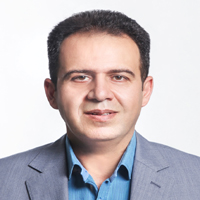Isolation and identification of oil sludge degrading bacteria from production tank Number 9 Masjed Soleiman
Author(s):
Abstract:
Introduction
“Bioremediation” is one of the most effective methods to remove petroleum contaminants. The aim of the present study is to isolate the indigenous bacteria from the waste petroleum in the Masjed Soleiman No. 9 production tank and to examine the effect of their application on the elimination of petroleum heavy chain hydrocarbons and converting them into light compounds. Materials And Methods
Two percent of petroleum sludge was inoculated to the mineral basal medium and after proliferation of its indigenous bacteria, they were inoculated into the mixture of oil sludge and sand at level of 5%, and the amount of total hydrocarbons and residual oil were measured and compared. The isolates were identified based on biochemical tests and 16S rRNA gene sequencing. Optimization of nitrogen and phosphate sources was done based on growth curves of selected isolates. Gas chromatography was used to determine degradation of sludge hydrocarbons. Results
In this study, 10 bacterial isolates were isolated from petroleum sludge. Measurement of petroleum total hydrocarbons, using Soxhlet-extraction method, showed that two isolates named MIS1 and MIS2 are able to decompose oil sludge hydrocarbons within 7 days, with the yields of 62% and 72%, respectively. Furthermore, the two isolates reach the end of the logarithmic phase at 48 and 120 hrs, respectively. The best source of nitrogen and phosphate for both isolates was ammonium nitrate and potassium di hydrogen phosphate, respectively. The isolates were identified as Arthrobacter aurescens and Pseudomonas aeruginosa, respectively. In gas chromatography analysis it was revealed that Pseudomonas aeruginosa was more potent in degradation of heavy chain hydrocarbons and their conversion to light chain compounds. Discussion and Conclusion
Resident bacteria are present in the oil sludge and are able to degrade the heavy petroleum compounds and convert them into light compounds. These bacteria are effective in the reduction of environmental pollution and production of low molecular weight hydrocarbons.Keywords:
Language:
Persian
Published:
Biological Journal of Microorganism, Volume:3 Issue: 10, 2014
Pages:
13 to 26
magiran.com/p1288601
دانلود و مطالعه متن این مقاله با یکی از روشهای زیر امکان پذیر است:
اشتراک شخصی
با عضویت و پرداخت آنلاین حق اشتراک یکساله به مبلغ 1,390,000ريال میتوانید 70 عنوان مطلب دانلود کنید!
اشتراک سازمانی
به کتابخانه دانشگاه یا محل کار خود پیشنهاد کنید تا اشتراک سازمانی این پایگاه را برای دسترسی نامحدود همه کاربران به متن مطالب تهیه نمایند!
توجه!
- حق عضویت دریافتی صرف حمایت از نشریات عضو و نگهداری، تکمیل و توسعه مگیران میشود.
- پرداخت حق اشتراک و دانلود مقالات اجازه بازنشر آن در سایر رسانههای چاپی و دیجیتال را به کاربر نمیدهد.
In order to view content subscription is required
Personal subscription
Subscribe magiran.com for 70 € euros via PayPal and download 70 articles during a year.
Organization subscription
Please contact us to subscribe your university or library for unlimited access!


